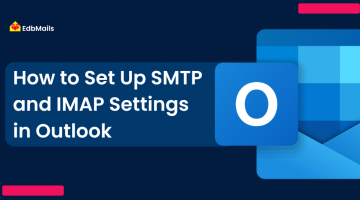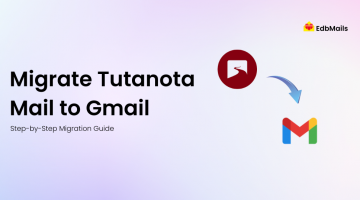Migrating from Exchange Server to Office 365 (Microsoft 365) is a major step toward digital transformation. With Office 365, businesses gain cloud-based access to Outlook, Teams, OneDrive, and SharePoint, boosting productivity, collaboration, and scalability.

However, migration requires careful planning. A poorly executed migration can lead to downtime, data loss, or compliance issues. That’s why having a structured Exchange to Office 365 migration plan — and the right tools like EdbMails Exchange Migration Tool — is critical to success.
This article walks you through:
- Why businesses move to Office 365
- Migration methods and how they work
- Challenges and risks of native migration
- Step-by-step migration plan with best practices
- How EdbMails ensures a smooth, secure, and downtime-free migration
Why Create an Exchange to Office 365 Migration Plan?
Office 365 offers numerous benefits that make migration attractive:
- Lower IT costs – No more server hardware, patching, or upgrades.
- Scalability – Add or remove users in minutes.
- Business continuity – Cloud access ensures work can continue from anywhere.
- Enhanced collaboration – Integration with Microsoft Teams, OneDrive, and SharePoint.
- Compliance & security – Encryption, DLP (Data Loss Prevention), GDPR and HIPAA readiness.
But migration is not as simple as flipping a switch. You need a clear plan that covers mailbox size limits, DNS changes, user training, and licensing. This is where EdbMails adds value — automating complex tasks, reducing downtime, and ensuring data integrity throughout the move.
Exchange to Office 365 Migration Types
Microsoft provides different migration methods. Your migration plan should consider which one suits your organization best.
1. Cutover Migration
- Suitable for: Small businesses (under 150 mailboxes).
- Approach: All mailboxes are moved in one batch.
- Native challenges: Downtime risks, PowerShell commands, and DNS changes.
- With EdbMails:
- Migrate all mailboxes or only selected ones.
- Fully automated process, no scripting required.
- Zero downtime for users.
- Migrate all mailboxes or only selected ones.
👉 Click here for the Exchange Cutover Migration using EdbMails
2. Staged Migration
- Suitable for: Medium-sized organizations with Exchange 2003/2007.
- Approach: Migrates users in multiple batches via CSV files.
- Native challenges: Manual batch management, directory sync requirements.
- With EdbMails:
- Batch migrations are simplified with point-and-click selection.
- Ensures folder hierarchy and permissions remain intact.
- Reduces errors and migration time.
- Batch migrations are simplified with point-and-click selection.
👉 Click here for the Staged Exchange Migration using EdbMails
3. Hybrid Migration
- Suitable for: Large enterprises (Exchange 2010, 2013, 2016).
- Approach: Coexistence of on-premises Exchange and Office 365.
- Native challenges: Complex setup with Hybrid Configuration Wizard.
👉 Click here for the Staged Exchange Migration using EdbMails
4. Office 365 Import Service
- Suitable for: PST-based migrations (when organizations have exported PST files from Outlook or Exchange).
- Native challenges: 10 GB PST file size limits, slow upload speeds, manual handling of multiple files, and risks of corruption.
With EdbMails:
- Directly migrates from source Exchange to Office 365 without requiring PST exports.
- Supports to import bulk PST files to Office 365 — multiple PSTs can be uploaded and mapped to their respective mailboxes in one go.
- No file size restrictions or risk of data corruption.
- Faster, safer, and far more efficient than the native import service.
Common Challenges in Exchange to Office 365 Migration
Even with a plan, native migration often faces challenges:
- Downtime & user disruption – Interrupts business operations.
- Complex scripting – Requires PowerShell knowledge.
- No selective migration – Entire mailbox must be moved.
- Public folders – Need a separate migration path.
- Mailbox size limits – Large mailboxes (>50 GB) need archiving.
👉 EdbMails solves these challenges with a GUI-driven tool, selective migration options, unlimited mailbox size support, and the ability to migrate public folders, shared mailboxes, and archive mailboxes.
Exchange to Office 365 Migration Plan
Here’s a practical migration roadmap:
- Assessment & Planning
- Audit Exchange environment.
- Clean up mailboxes (archive old data).
- Decide between Cutover, Staged, or Hybrid.
- Audit Exchange environment.
- Pre-Migration Setup
- Update Exchange Server.
- Verify SSL certificates & Autodiscover.
- Communicate with users about changes.
- Update Exchange Server.
- Pilot Migration
- Test with a small set of users.
- Run a pilot using EdbMails’ selective migration feature.
- Test with a small set of users.
- Full Migration Execution
- Create migration batches (if needed).
- Sync mailboxes to Office 365.
- With EdbMails, users can continue working while data is migrated in real-time.
- Create migration batches (if needed).
- DNS & Post-Migration Steps
- Update DNS MX records.
- Assign Office 365 licenses.
- Verify mail flow and Autodiscover.
- EdbMails Automatically generates Exchange migration reports to help validate migration success.
- Update DNS MX records.
How to Perform Exchange to Office 365 Migration
Performing an Exchange to Office 365 migration involves preparing your environment, selecting the right migration method, and executing the move with minimal disruption. The process includes assessing your current Exchange setup, verifying prerequisites, planning mailbox moves, configuring DNS, and validating data post-migration.
To simplify the process, EdbMails provides a step-by-step migration guide that walks you through every stage — from setup to completion — ensuring a smooth and secure transition.
👉 Follow the detailed instructions here: EdbMails Exchange to Office 365 Migration Guide
Cost Considerations
- Native migrations: Free but costly in terms of IT labor, downtime, and risk.
- EdbMails migration: Affordable licensing, faster execution, reduced errors, and minimized downtime — lowering the total cost of ownership (TCO).
Security & Compliance
- Native tools: Require manual handling of security and authentication configurations.
- EdbMails ensures:
- OAuth 2.0 Modern Authentication support for secure sign-ins with Office 365 and Exchange, eliminating reliance on outdated basic authentication.
- AES 256-bit end-to-end encryption for data protection.
- Full compliance with GDPR, HIPAA, and ISO 27001 standards.
- Detailed audit logs for governance, monitoring, and reporting.
- OAuth 2.0 Modern Authentication support for secure sign-ins with Office 365 and Exchange, eliminating reliance on outdated basic authentication.
👉 More details on Exchange Migration Security
Best Practices for Migration
- Define a clear migration timeline.
- Archive large mailboxes before moving.
- Start with a pilot migration.
- Communicate changes to users early.
- Use EdbMails filters to migrate only relevant data.
- Validate post-migration with built-in EdbMails reports.
Final Thoughts
A successful Exchange to Office 365 migration plan requires more than just choosing a method — it needs the right tools, planning, and execution.
While Microsoft’s native options (Cutover, Staged, Hybrid, Import Service) are available, they come with complexity, risks, and downtime. EdbMails offers dedicated software for Exchange Migration offers a better way — with automation, selective migration, compliance support, and zero downtime.
👉 Next Step: Start your migration with a pilot using EdbMails Exchange Migration Tool and ensure a smooth, secure, and cost-effective move to Office 365.



